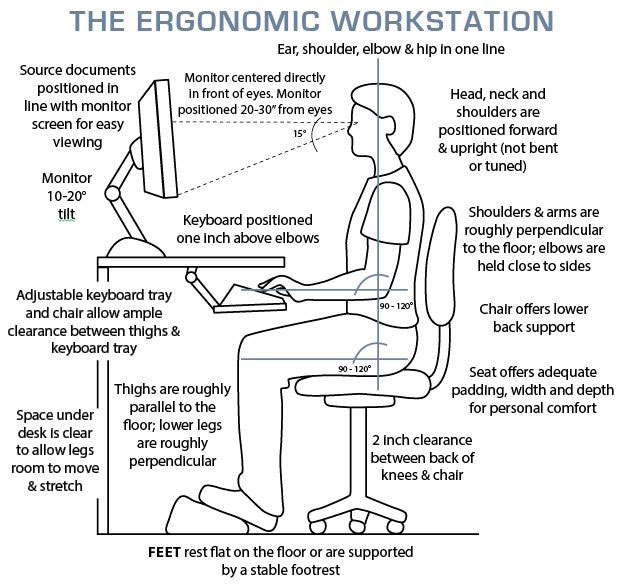How can you adopt a good posture at work while sitting at your desk? How important is it that you do it? For your health, well-being productivity – it matters a lot. Let us explain.
Let’s start with an interesting fact: if you have an “office job”, sitting at a desk is probably the activity you will spend most of your life on – even more than sleeping, that’s right.
Studies show that the average office worker spends between 8 and 12 hours a day sitting (either at a desk, watching TV, or on transportation). By the end of your life, you will have spent about a third of your time sitting – most often, sitting at a desk. Yet, while sitting still is among the things we do the most, we rarely worry about how to do it right, that is, how to keep the right posture at work – despite studies showing there are both good posture and bad postures.
The sitting position is scientifically recognized as one of the worst from the health point of view. It affects our metabolism, our good posture or the health of our joints. Sit poorly and see all these problems reach another (more complicated) level. What’s why it is so important to know how to adopt a good posture while sitting at work.
Why Worrying About Having Good A Posture At Work?
Obviously, there are always times in life when we adopt bad or non-ideal postures. Not having a perfect posture from time to time is no reason for alarm. However, when it comes to our posture at the office, our concern should be increase as, like we’ve been discussing, we spend most of our time sitting at our desks.
When our body remains in a position for a long period and the same gestures are often repeated, our body tends to naturally adjust to such postures or gestures. So when you spend a huge part of your day sitting at your desk, your body adapts and some muscles get more tightened while others relax and weaken.
After a while, the tensions in our bodies caused by our posture and gestures slightly (but surely, in the long term) shift the balance of certain joints and cause us pain. Ultimately, this can even lead to relatively serious pathologies: sciatica pain, osteoarthritis, joint arthritis or even herniated discs. This is why adopting ergonomic principled at work is so important.
What Is A Good Posture At The Office?
While a posture is a position the body stands in space, a good posture is a posture that respects the natural position of our joints and the muscular balance of our body. Be it standing, walking, sitting at the desk, cooking or watching TV – there are postures that respect these balances and others that compromise them.
In terms of sitting position, the ideal position is one that allows the main joints of the body to be in a neutral position that does not cause muscles too much tension or require much stretching. This means that you must avoid bending or arching your back too much, bending or stretching your legs too much and activating your hip flexion too much. In summary, the ideal posture looks like this:

The key points to remember regarding the ideal position to sit at work are:
- Keep your back straight, in particular:
- Avoid rounding your shoulders forward (for this, you must have your screen at your eye level)
- Avoid rounding (or arching) your lower back
- Keep your shoulders relaxed and back
- Place your elbows so that they form an angle of 90-100 degrees (never less)
- Keep your knees at a height of your hips (the thighs should form an angle of 90-100 degrees with the torso)
- Leave your legs relaxed, bent at about 90-100 degrees, leave your feet resting on the ground and do not cross your legs.
How To Adjust Your Desk And Workspace Smoothly To Have The Best Sitting Position?
To sit consistently with a good posture, focusing on the right position and movements is not enough – you need extra help from the right equipment.
If your desk is standing too high or too low, if your chair causes you a sloppy posture or if your computer screen is poorly positioned – it doesn’t matter how concentrated or motivated you are – ods are you will end up with a bad posture over time.
In this way, to have your workspace properly organized to support your good posture, you should invest in the right equipment. Here’s what you might need:
- A height-adjustable chair with a backrest (essential);
- A desk;
- An external screen or a laptop-stand (if you are using a laptop);
And here is some advice on what you can do to keep a good posture at work:
1- Adjust Your Chair So You Can Keep A Good Sitting Position
You must first have a height-adjustable chair. It is certainly an investment, but it will be worth it. If you cannot adjust your chair, you will not be able to adapt it to your size and you will almost certainly end up having a bad posture. Unless you perfectly match the size and proportions of your chair – but then you won’t be able to influence others around you to follow your ergonomic example.
In any case, if possible, adjust your chair so that when you are sitting the bottom of your elbows are at the height of your desk (or slightly higher). If you lay your hands flat on your desk with your arms alongside your body, your elbows should form about a right angle.
2- Position Your Feet And Legs Correctly
Make sure that once seated, you can position your legs and feet correctly. Your thighs should form an angle of about 90-100 degrees with your torso, and your calves should form an angle of about 90 degrees with your thighs.
You should also be able to put your feet flat on the ground without your legs being contracted. In general, for a medium-sized person, this is not a problem. But if you are very tall or rather short, this can be a problem. In case your feet do not touch the ground, it may be that your desk is a little too high. In this case, simply use a footrest (or a cardboard box or any other flat object on which you can put your feet upon).
If on the contrary, you notice your legs are too high or that you are forced to extend them forward – this is trickier. This means your desk is too low and you may need to consider changing it or raising it with shims if you are a handy person.
Remember as well to not cross your legs or feet. This tends to make one leg work more than the other and it can lead to muscular imbalances in the pelvis… This also increases the risk of back problems because our spine is no longer properly aligned.
3- Choose A Screen With The Ideal Height
For an ideal sitting position at work, your screen should be approximately at eye level. You should be able to look at it without lowering your head and without having to lower your gaze too much – which tends to make your back bend and therefore tire your upper back muscles.
Forget about your laptop screens. They are too small and above all too low to match your eye level Here the ideal solution would be to buy an external display that you plug into your laptop and whose height you can adjust (if not, use a box or books to heighten it up). This would also be a larger screen that would allow working without bending your upper back and neck. An adjustable laptop stand would also help place the monitor higher but its value would ultimately depend on the size of your laptop’s screen (an 11 inches screen is likely too small)
A Good Posture At Work – Go For It

With all this information you now know what’s most important to keep in mind regarding the ideal working posture while sitting at your desk.
These are small changes that require a little investment (especially for the chair and the external screen), but that have the potential to greatly improve your health, well-being, and productivity. A
Even if today you don’t feel the negative effects of poor posture at work, they will most likely show up with time and the repetition of poor postures. So it is best is you start ASAP.
[Photo by Tim van der Kuip on Unsplash and posture on Shutterstock]

